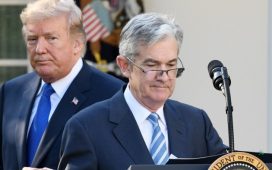This article is an on-site version of our Unhedged newsletter. Sign up here to get the newsletter sent straight to your inbox every weekday
Good morning. Nothing much of interest happened here in New York yesterday, so we decided to take a step back and look at both the economic backdrop and stock market leadership. We are keen to hear your thoughts on either: robert.armstrong@ft.com & ethan.wu@ft.com.
Unhedged subscribers may be interested in the FT’s new One Must-Read newsletter, which brings readers the most exceptional story from the FT each weekday. You can sign up by clicking here.
A confusing economy nears the end of the cycle
Friday’s jobs report will probably be this week’s marquee market event, but yesterday offered a little teaser. February’s Jolts numbers revealed a big drop in jobs postings, to 9.9mn from 10.6mn in January. Expectations had been for just a small nudge down to 10.5mn. Bonds rallied, led by the two-year, the yield on which fell 16bp. The end to the tightening cycle is in view, the market thinks; futures-implied odds of a rates pause at the Fed’s May meeting rose above 50/50.
The job openings number shares a mild recessionary odour with the weak ISM manufacturing survey for March, released Monday. Put the two together, and it looks as if the economy’s chief source of resilience — robust consumption propped up by even stronger employment conditions — is wobbling.
Start with the Atlanta Fed’s GDPNow forecast, which after several downward revisions sits at a still-OK 1.7 per cent:

The sharpest recent drop-off came after Monday’s soft ISM numbers. The headline index and the forward-looking new orders index remained mired in contraction territory, but the main news came in the employment subcomponent — the weakest it’s been since the depths of the pandemic. This line from ISM stood out to us:
Panellists’ comments now indicate equal levels of activity towards expanding and contracting headcounts at their companies, amid mixed sentiment about the return of growth early in the second half of the year.
Some reports of labour hoarding are still out there, but the mood has shifted considerably towards hiring getting easier. The job openings numbers and the ISM survey are singing the same tune.
But as we’ve taken to saying, the economy’s overriding feature right now is that it is confusing. Mixed signals abound. Take February’s personal consumption expenditure data, released on Friday. It showed a slight deceleration in month-over-month prices and in both goods and services consumption, but only after a big January spending binge (and price rise). That left the trend in real consumption growth somewhere between up and sideways:

Even within yesterday’s Jolts report there were mixed signals. The quits rate is generally considered a more reliable indicator of labour market tightness than the number of openings (after all, it’s easy to post a job opening). The quits rate rose to 2.6 per cent, still well higher than the 2.3 per cent rate seen before the pandemic. And as Deutsche Bank’s Matthew Luzzetti pointed out last week, much of the recent decline in the quits rate comes down to one sector: professional services. Strip that out and the labour market looks even tighter. This chart from Harvard’s Jason Furman suggests little reason to bet on labour market loosening:

The ISM survey, too, looks worse than the other manufacturing activity survey, released by S&P:

The truth is that for all the (we think valid) reasons to suspect the economy is bound for recession eventually, it is not obvious in the contemporaneous data. That key pillar of resilience, consumption, is holding firm. The labour market, while not as tight as it was, is by all measures still tight. Manufacturing has in the past gone through several months of contraction without spilling into a broader recession.
The case for recession has to be made in a forward-looking way. The Fed might pause in May but rates, at 5 per cent, have already felled a few banks. With deposit costs rising, there is every reason to expect lending conditions to tighten. Consumers’ excess savings are expected to run dry sometime in the autumn. And, most importantly, until inflation unsticks, rates can’t be cut. This is not an easy set-up for the economy, nor for risk assets. (Ethan Wu)
The tech bounce
Here’s a chart:

Those are of six of the seven best-performing stocks in the S&P 500 year to date. These index-leaders have a lot in common, as reflected in their shared Nike-swoosh-like pattern of price performance since late 2021.
All are techs (or are at least tech-adjacent, in case of Align, which makes whizzy teeth-straightening products). All have had wild rallies during the pandemic, peaked in late ‘21, and then got absolutely clobbered in ‘22. Their low points came, conveniently, right around the end of that year. In ‘23, they are all up by at least 48 per cent. All remain below their pandemic highs, though; all but Nvidia are below them by a lot. Finally, they are not cheap stocks. The cheapest among them, Meta, a 22 times forward earnings, enjoys a small premium to the market. Nvidia is on 60 times.
Collectively, these stocks are big enough that their leadership matters: their total market cap in $2.2tn, or more than 6 per cent of the S&P.
I find the chart slightly worrisome. If the market is anticipating a return to the happy regime of 2020-2021, with rates falling near to zero again while tech stocks trade at fat multiples, it is setting itself up for disappointment. Even if rates have peaked, things have changed, and the old days are not coming back. Once this becomes clear, the tech bounce — a key support for the market year-to-date — could well fall away.
There are, however, reasons to think that the momentum will continue. To start, two of the companies in the chart above, Meta and Salesforce, are rallying at least in part because management is trying to pivot towards profitability and shareholder returns. The effectiveness of these pivots is still to be proven, but at least there is a fundamental story in place.
Next, two of the other leaders, Nvidia and AMC, are semiconductor stocks and, as Jefferies analyst Sean Darby has argued, the semiconductor cycle looks to be near a bottom. His chart:

Next, we may have simply seen tech earnings and share prices overshoot relative to their long-term trend, and then overcorrect. They can now return to their very benign long-term trend. Binky Chadha of Deutsche Bank provides this (log scale) chart of the relative performance of megacap growth and tech to the rest of the S&P:

That trend is supported, in turn, by strong long-term earnings growth:

The hard question is whether the whole post-2008 period of torrid earnings growth and stock appreciation were themselves a historical anomaly. I’m not sure. But it is clear that the fate of great tech bounce is crucial for US stock investors’ near-term prospects.
One good read
More on the new obesity drugs.








